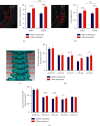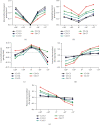Effect of a Traction Exercise Neck Brace on Cervical Spondylopathy Radiculopathy: A Clinical Study and Finite Element Analysis
- PMID: 33936246
- PMCID: PMC8060117
- DOI: 10.1155/2021/8825150
Effect of a Traction Exercise Neck Brace on Cervical Spondylopathy Radiculopathy: A Clinical Study and Finite Element Analysis
Abstract
Traction of cervical spine is an effective method for the treatment of cervical spondylotic radiculopathy (CSR). In this study, a cervical tractor named traction exercise neck brace (TENB) was used to evaluate its effect on the patients with CSR. Forty CSR volunteers were recruited and randomly divided into two groups. One group was subjected to cervical muscle exercise with TENB under static traction condition. Another group was subjected to (JOBT) as controls. Symptoms of CSR were evaluated by the visual analogue scale (VAS) and neck disability index (NDI). Imaging characteristics were assessed by curvature of the cervical spine and size of the intervertebral foramen. A finite element (FE) analysis model of cervical spine was established by 3D reconstruction to simulate the TENB traction, which evaluates the biomechanical performance. Results showed that TENB significantly reduced scores of VAS and NDI in subjects, and this improved effect on symptoms of pain and radiculopathy is better than that of JOBT. TENB also improved the cervical curvature and enlarged intervertebral foramen at the C4-C6 level. Moreover, FE analysis found that simulated TENB traction increased the spacing of intervertebral foramen, intervertebral disc, and zygapophyseal and uncovertebral joints and changed the stress distribution on the facet joints and nucleus pulposus. This study demonstrates that TENB relieves the symptoms of CSR by adjusting structure of cervical vertebra and restoring its biomechanical performance, which may be a promising instrument in the treatment of CSR.
Copyright © 2021 Liang-Xing Xiao et al.
Conflict of interest statement
The authors declare no conflicts of interest in this study.
Figures





Similar articles
-
[Finite element analysis of the treatment of cervical spondylotic radiculopathy with three dimensional balanced manipulation].Zhongguo Gu Shang. 2020 Sep 25;33(9):867-72. doi: 10.12200/j.issn.1003-0034.2020.09.015. Zhongguo Gu Shang. 2020. PMID: 32959577 Chinese.
-
Effect of cervical spine motion on displacement of posterolateral annulus fibrosus in cervical spondylotic radiculopathy with contained posterolateral disc herniation: a three-dimensional finite element analysis.J Orthop Surg Res. 2022 Dec 18;17(1):548. doi: 10.1186/s13018-022-03450-5. J Orthop Surg Res. 2022. PMID: 36528646 Free PMC article.
-
Balance chiropractic therapy for cervical spondylotic radiculopathy: study protocol for a randomized controlled trial.Trials. 2016 Oct 22;17(1):513. doi: 10.1186/s13063-016-1644-2. Trials. 2016. PMID: 27770801 Free PMC article. Clinical Trial.
-
Management of Cervical Spondylotic Radiculopathy: A Systematic review.Global Spine J. 2022 Oct;12(8):1912-1924. doi: 10.1177/21925682221075290. Epub 2022 Mar 24. Global Spine J. 2022. PMID: 35324370 Free PMC article. Review.
-
Pediatric cervical kyphosis in the MRI era (1984-2008) with long-term follow up: literature review.Childs Nerv Syst. 2022 Feb;38(2):361-377. doi: 10.1007/s00381-021-05409-z. Epub 2021 Nov 22. Childs Nerv Syst. 2022. PMID: 34806157 Review.
Cited by
-
Clinical Observation of MRI Image in Floating Needle Therapy for Cervical Spondylosis of Cervical Type.Scanning. 2022 May 24;2022:1340192. doi: 10.1155/2022/1340192. eCollection 2022. Scanning. 2022. Retraction in: Scanning. 2023 Jun 21;2023:9864261. doi: 10.1155/2023/9864261. PMID: 35795613 Free PMC article. Retracted. Clinical Trial.
-
Human head-neck model and its application thresholds: a narrative review.Int J Surg. 2025 Jan 1;111(1):1042-1070. doi: 10.1097/JS9.0000000000001941. Int J Surg. 2025. PMID: 38990352 Free PMC article. Review.
-
Comparison of clinical outcomes and complications of biportal and uniportal endoscopic decompression for the treatment of cervical spondylotic radiculopathy: A systematic review and meta-analysis.Jt Dis Relat Surg. 2024 Aug 14;35(3):583-593. doi: 10.52312/jdrs.2024.1820. Epub 2024 Aug 14. Jt Dis Relat Surg. 2024. PMID: 39189567 Free PMC article.
References
LinkOut - more resources
Full Text Sources
Other Literature Sources
Miscellaneous

